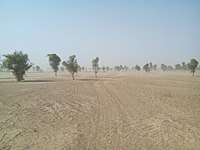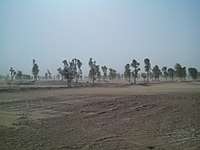Kachho
Kachho or Kachho Desert (Sindhi: ڪاڇو, Urdu: کاچھو) is desert of Sindh, Pakistan.[1][2] The Kachho is denoted from word of Sindhi language Kachh which stands for a lap or an armpit.[3] The desert of Kachho is near the lap of Kirthar Mountains Range.History reveals that the area of Kachho desert including the Lake Manchar appeared in the result of flow of big branch of Indus River in earliest times which had been flowing from Kashmore-Kandhkot to Luki Mountains.[3] It is spread over two districts of Sindh Province, Dadu District and Qambar Shahdadkot District.[4] Kachho is rich in fertile soil and forests.[5] The Kachho is affluent in archaeological and historical sites.[6] The several historic and prehistoric remains of civilizations can be observed herein Kachho desert from Neolithic and Bronze Age to British period.[3] The people cultivate many kind of crops in Kachho.[7] Kachho depends on rains. If it rains Kachho becomes prosperous because people cultivate lands and crops which boost the economy of the region including whole country. Due to rains the water level too increases and an environment also becomes pleasant. Mostly, the trees are big reason for heavy rains and good environment of the area. Numerous trees of Kachho desert have been cutting for sell since last many years. Thus, the environment is very pretentious and water level is dropped from 150 feet to 450 feet. The wells dug by people now became dry. The people of several villages of Kachho suffer for fresh drinking water.[8][9]

Gallery
 A view of desert area of Kachho
A view of desert area of Kachho Forest in desert area of Kachho
Forest in desert area of Kachho Different kind of trees in desert area of Kachho
Different kind of trees in desert area of Kachho
References
- Bux Khushik, Allah (15 December 2017). "Kachho festival concludes in Dadu". Daily Messenger. Retrieved 20 January 2018.
- "Forgotten people of Wahi Pandhi". Daily Times. 19 January 2018. Retrieved 20 January 2018.
- InpaperMagazine, From (2012-12-16). "Heritage: Legends on the walls". DAWN.COM. Retrieved 2018-06-18.
- Tunio, Hafeez (10 September 2017). "Tomb raiders leave little of Sindh's heritage intact". The Express Tribune. Retrieved 20 January 2018.
- Khushik, Imdad Ali (16 November 2017). "Sindh govt urged to protect forests". Daily Times. Retrieved 20 January 2018.
- "Expert sounds alarm over state of heritage sites in Kachho". Dawn. Dadu. 15 December 2017. Retrieved 20 January 2018.
- "In this mass exodus from Dadu, families flee not from conflict but in search of water". The Express Tribune. May 9, 2011.
- Khushik, Qurban Ali (2009-10-31). "Tree felling, depleting water reserves cause climate changes in Kachho". DAWN.COM. Retrieved 2018-06-18.
- "Timber mafia active in Kachho & Pai". DAWN.COM. 2009-11-13. Retrieved 2018-06-18.